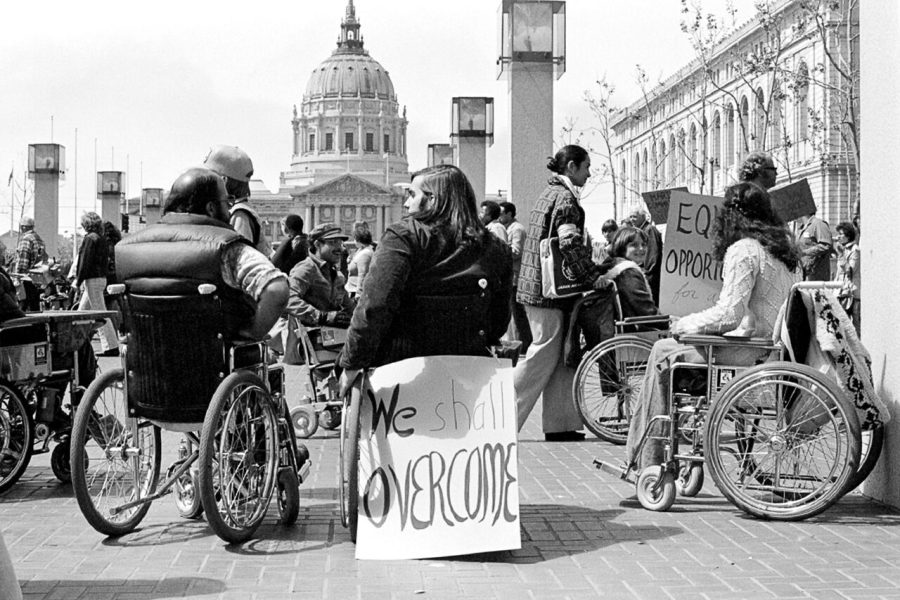Section 504: The Beginning of Disability and Civil Rights
May 8, 2023
Disability advocacy, awareness, and accessibility within the United States are contingent on legal protections in the form of civil rights. The fight for these protections dates back to the 1800s, but the culmination of broad Civil Rights movements during the 1960s and 70s finally granted disabled Americans much-needed support. The organization of disabled people towards a common goal meant power in numbers, and their rights became ones that the government could no longer deny.
The first recognition of disability in civil rights laws came in Section 504 of the Rehabilitation Act of 1973. This law meant federally funded institutions, including workplaces and schools, could not discriminate against disabled individuals. As monumental as this law was for the rights of disabled people, the fight for such protections demonstrates the often misguided historical societal and legal perception of disability.
Before Section 504, the burden of accessibility fell on the disabled person. Meaning it was not the job of any institution to create an accessible environment rather it was the job of the disabled person to adapt to the environment as it existed. This idea meant schools, workplaces, and entire communities turned away disabled people solely due to their disability. Section 504 flipped this narrative and forced federal institutions to address their discriminatory practices and create equal opportunity for disabled people.
The issue with Section 504 came in its implementation, as guidelines for non-discrimination needed to be set in the form of regulations. These regulations were necessary to offer concrete protection to disabled Americans, but the Department of Health Education Welfare (HEW) had yet to deliver any by 1977, and federally funded spaces continued to discriminate against disabled people. The American Coalition of Citizens with Disabilities (ACCD) was formed to advocate for these regulations, as the HEW, which was responsible for delivering them, had no disabled people present in their meetings and was determined to limit the protections granted to disabled Americans. In clear violation of the rights of disabled people, the ACCD, alongside other disability rights organizations and civil rights movements, organized sit-ins at federal buildings, demanding the HEW adopt the regulations they presented in full.
By April 5th, 1977, regulations still were not implemented, and across the country, disabled protestors swarmed HEW office buildings fighting for their civil rights. The sit-in at the federal office building in San Francisco lasted 26 days. The diversity of disabilities present in that sit-in showed the country how all disabled people united in demanding fair treatment throughout every aspect of their lives.
Other marginalized groups joined the protests, as Black Americans fought for the same treatment in the same way just a decade prior, the disability advocacy movement echoing the Civil Rights movement of the 1960s. The protestors understood that a decade later, public bus systems were still making headlines as vehicles of discrimination towards a specific group of Americans. Finally, Section 504 included disability in the broader fight against discrimination. Organizations like the Black Panther Party lent food and supplies to the protestors, recognizing a need for these regulations. The combined effort of these groups, and a sit-in in Washington, meant the HEW finally established regulations that sought to increase equity and inclusion of disabled people.
The government never enforced Section 504 to the extent that it should have been, as the Department of Transportation would fight the regulations on public transportation, and the regulations were overruled in court in 1980. Discrimination against disabled people continued throughout the country, but Section 504 still changed the way disability was treated in the United States. The notion that disabled people are not hindered by their disability, but by society’s treatment of them was brought forward through the fight for Section 504, a sentiment which continued under the passage of the Americans with Disabilities Act.
Protesters had been fighting against the narrative surrounding disabilities their entire lives and were eager to continue to make a change. One protestor, Judy Heumann, who protested in the Section 504 sit-ins, used what she had seen to propel the principles of non-discrimination within the ADA. Like many disabled activists at the time, she formed and operated many disability advocacy groups in support of disabled people all around the world. Heumann passed away on March 4th, 2023, but her work for disabled people serves as a legacy that will continue to expand as the fight for disabled rights continues.
Disabled people continue to face discrimination in many forms, as the promises made through Section 504 and the ADA have yet to come to fruition for many disabled Americans. As the fight continues, the narrative set by Section 504 continues to spread, and equity for disabled people continues. During Disability Advocacy Month and beyond, recognizing the importance of unified movements for disability rights is vital to the continued fight for equal rights for all Americans. The government has the tools to improve the lives of disabled Americans, and fighting for the implementation of further protections must be at the forefront of activism because, as the Section 504 protestors showed the United States, society is holding back disabled people, not disability.














